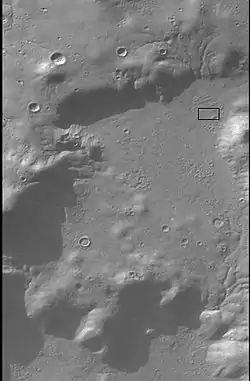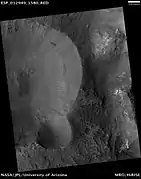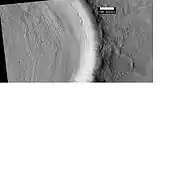Terrain softening
The landscape polewards of around 30 degrees latitude on Mars has a distinctively different appearance to that nearer the equator, and is said to have undergone terrain softening. Softened terrain lacks the sharp ridge crests seen near the equator, and is instead smoothly rounded. This rounding is thought to be caused by high concentrations of water ice in soils. The term was coined in 1986 by Steve Squyres and Michael Carr from examining imagery from the Viking missions to Mars.

Below 30 degrees of latitude, impact craters have steep walls; well-defined, sharp rims; and flat or smoothly bowl-shaped floors. Ridges on intercrater plains come to similarly well-defined, pointed crests. However, above this latitude, these same features appear very different. The crests seen on ridges and crater rims appear strongly rounded and much more poorly defined. The relief (height) of features is somewhat reduced. Small craters are noticeably less common. In other words, terrain which elsewhere looked sharp here looks "soft".[1][2][3] This texture has also been described as "smooth", or "rolling".[4] Softened craters are also commonly infilled with concentric patterns on their floors.[2]
On Earth, diffusive creep of soils is associated with rounded hillslopes.[5][6] Squyres and Carr thus attributed the softened texture to accelerated viscous creep in shallow soils near the surface, and went on to associate this accelerated creep with the presence of ground ice at these latitudes.[1] This conclusion has been largely borne out by subsequent research.[2][7] In the late 1980s some attempts were made to link terrain softening with dust and aeolian processes,[8][9] though this hypothesis has largely been superseded by more recent observations.[2]
Terrain softening is one of a suite of features seen in the midlatitudes of Mars—also including lobate debris aprons, lineated valley fill, concentric crater fill, latitude dependent mantle, patterned ground, viscous flow features, arcuate ridges, recurring slope lineae, and gullies—whose form and distribution strongly suggest the abundance of ice at the surface.[2]
Contrast between softened and unsoftened terrain
- Unsoftened terrain
 Zumba crater, 29° S
Zumba crater, 29° S Small craters inset within Saheki crater, 22° S
Small craters inset within Saheki crater, 22° S Crater in Arabia Terra, 13° N
Crater in Arabia Terra, 13° N Sharp terrain in Radau crater, 17° N
Sharp terrain in Radau crater, 17° N
- Softened terrain
 Part of crater rim and concentric crater fill in the Eridania quadrangle, 39° S
Part of crater rim and concentric crater fill in the Eridania quadrangle, 39° S Unnamed crater, 36° S
Unnamed crater, 36° S Unnamed crater with concentric crater fill, 41° S
Unnamed crater with concentric crater fill, 41° S Unnamed crater with concentric crater fill, 38° S
Unnamed crater with concentric crater fill, 38° S
See also
- Climate of Mars – Climate patterns of the terrestrial planet
- Geology of Mars – Scientific study of the surface, crust, and interior of the planet Mars
- Periglaciation
- Permafrost
- Solifluction – Freeze-thaw mass wasting slope processes
- Water on Mars – Study of past and present water on Mars
References
- Squyres, Steven W., and Michael H. Carr. "Geomorphic evidence for the distribution of ground ice on Mars." Science 231.4735 (1986): 249-252.
- Carr, Michael H. The surface of Mars. Vol. 6. Cambridge University Press, 2006.
- Zimbelman, James R. "Spatial resolution and the geologic interpretation of Martian morphology: Implications for subsurface volatiles." Icarus 71.2 (1987): 257-267.
- Jankowski, David G., and Steven W. Squyres. "The topography of impact craters in “softened” terrain on Mars." Icarus 100.1 (1992): 26-39.
- Roering, Joshua J., James W. Kirchner, and William E. Dietrich. "Evidence for nonlinear, diffusive sediment transport on hillslopes and implications for landscape morphology." Water Resources Research 35.3 (1999): 853-870.
- Rosenbloom, N. A., and Robert S. Anderson. "Hillslope and channel evolution in a marine terraced landscape, Santa Cruz." California: Journal of Geophysical Research 99.B7 (1994): 14-013.
- Berman, Daniel C., David A. Crown, and Leslie F. Bleamaster III. "Degradation of mid-latitude craters on Mars." Icarus 200.1 (2009): 77-95.
- Zimbelman, J. R., S. M. Clifford, and S. H. Williams. "Terrain Softening Revisited: Photogeological Considerations." Lunar and Planetary Institute Science Conference Abstracts. Vol. 19. 1988.
- Clifford, S. M., and J. R. Zimbelman. "Softened Terrain on Mars: The Ground Ice Interpretation Reconsidered." Lunar and Planetary Institute Science Conference Abstracts. Vol. 19. 1988.